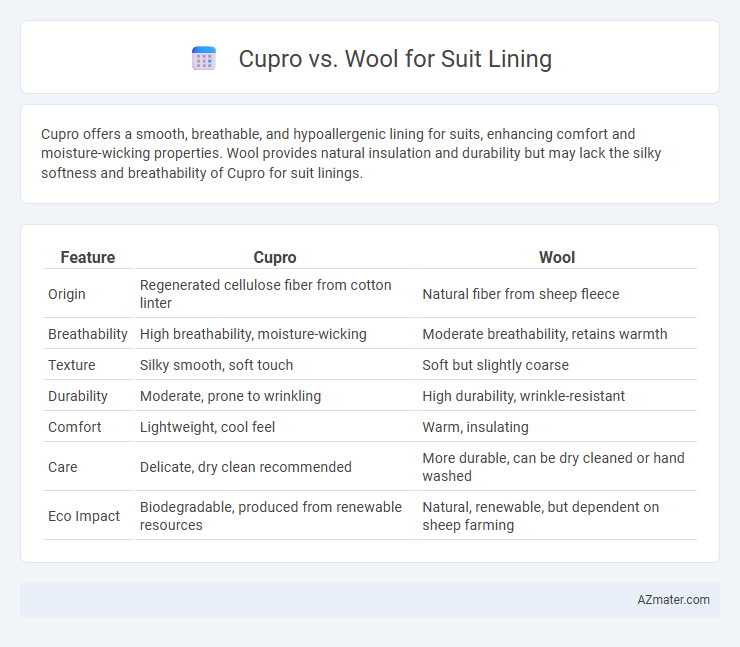Cupro offers a smooth, breathable, and hypoallergenic lining for suits, enhancing comfort and moisture-wicking properties. Wool provides natural insulation and durability but may lack the silky softness and breathability of Cupro for suit linings.
Table of Comparison
| Feature | Cupro | Wool |
|---|---|---|
| Origin | Regenerated cellulose fiber from cotton linter | Natural fiber from sheep fleece |
| Breathability | High breathability, moisture-wicking | Moderate breathability, retains warmth |
| Texture | Silky smooth, soft touch | Soft but slightly coarse |
| Durability | Moderate, prone to wrinkling | High durability, wrinkle-resistant |
| Comfort | Lightweight, cool feel | Warm, insulating |
| Care | Delicate, dry clean recommended | More durable, can be dry cleaned or hand washed |
| Eco Impact | Biodegradable, produced from renewable resources | Natural, renewable, but dependent on sheep farming |
Introduction to Suit Lining Fabrics
Cupro and wool are popular suit lining fabrics known for their distinct properties and comfort. Cupro, made from regenerated cellulose fibers, offers breathability, a silky texture, and excellent moisture-wicking, making it ideal for warm climates. Wool linings provide natural insulation, durability, and moisture management, enhancing comfort and structure in colder seasons.
What is Cupro?
Cupro is a regenerated cellulose fiber made from cotton linter, known for its smooth, silk-like texture and breathable properties, making it an excellent choice for suit linings. Unlike wool, which provides natural insulation and warmth, cupro enhances comfort by promoting moisture-wicking and temperature regulation. Its hypoallergenic and sustainable attributes contribute to its increasing popularity as a high-quality alternative in luxury tailoring.
What is Wool Lining?
Wool lining in suits is made from natural fibers harvested from sheep, known for its excellent insulation and moisture-wicking properties. This material provides breathability and warmth, making it ideal for cooler weather while maintaining comfort throughout the day. Compared to cupro, wool offers superior durability and a more traditional, luxurious feel in suit construction.
Cupro vs Wool: Breathability and Comfort
Cupro offers superior breathability compared to wool, making it an excellent choice for suit linings in warm climates or for those seeking all-day comfort. Its smooth, silky texture reduces friction against the skin, enhancing overall wearability, while wool linings, though warmer, can sometimes feel less breathable and heavier. Cupro's moisture-wicking properties also help maintain dryness, ensuring a comfortable fit even during extended wear.
Durability Comparison
Cupro suit linings offer moderate durability with smooth texture and breathability, making them resistant to wear over time but prone to delicate care requirements. Wool linings provide superior durability due to their natural resilience, excellent elasticity, and moisture-wicking properties, ensuring long-lasting performance and shape retention in suits. For durability-focused suits, wool linings outperform cupro by maintaining structural integrity through extended use and frequent wear.
Moisture Management and Temperature Regulation
Cupro excels in moisture management due to its high breathability and ability to wick sweat away from the skin, keeping the wearer dry and comfortable. Wool offers superior temperature regulation by insulating heat in colder conditions while remaining breathable enough to avoid overheating. Suit lining made from Cupro ensures a lightweight and cool experience, whereas wool provides warmth and natural thermoregulation for varying climates.
Environmental Impact: Sustainability of Cupro and Wool
Cupro, derived from natural cotton fibers through a closed-loop production process, is biodegradable and offers a more sustainable alternative to synthetic suit linings. Wool, sourced from sheep, is renewable and biodegradable but its environmental impact varies based on farming practices, with concerns about methane emissions and land use. Choosing Cupro or responsibly farmed wool significantly reduces the ecological footprint associated with suit lining materials.
Maintenance and Care Requirements
Cupro suit linings require gentle hand washing or dry cleaning to prevent fabric damage, with attention to avoiding high heat during ironing due to its delicate fibers. Wool linings demand more rigorous maintenance, including professional dry cleaning to preserve texture and shape, as wool is prone to shrinking and pilling if washed improperly. Both materials benefit from proper storage in a cool, dry place to prevent moisture damage and maintain longevity.
Aesthetic and Feel: Cupro vs Wool
Cupro offers a smooth, silk-like finish that enhances the elegance and drape of a suit lining, providing a luxurious aesthetic with a soft, breathable feel ideal for warm climates. Wool linings deliver a natural texture with insulating properties, creating a thicker, more structured appearance that contributes to a refined, classic look and a cozy tactile experience. Both materials balance style and comfort, but Cupro excels in lightweight breathability while Wool emphasizes warmth and traditional sophistication.
Choosing the Best Lining for Your Suit
Cupro offers excellent breathability and a silky smooth texture, making it an ideal choice for suit linings in warmer climates. Wool linings provide superior insulation and moisture-wicking properties, perfect for colder weather and enhancing durability. Selecting the best suit lining depends on factors like climate, comfort preferences, and the balance between breathability and warmth.

Infographic: Cupro vs Wool for Suit Lining
 azmater.com
azmater.com